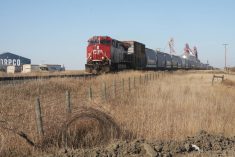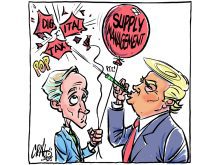On April 6, a letter printed in the Saskatoon Star Phoenix by Joe Monahan suggested that farm technology is advancing an ecological disaster.
He started by saying many farmers are conscientious stewards of the land, but with the increase in farm size, there is a trend to drain sloughs and push bluffs to make long square fields so auto steer can drive equipment straight.
Let’s look at this. How about we start with the price of land?
Read Also

Agriculture needs to prepare for government spending cuts
As government makes necessary cuts to spending, what can be reduced or restructured in the budgets for agriculture?
Over the past 20 years, land has appreciated 10 to 15 times in value. The cheapest way to get more land is to develop the land you already own.
We are all about clean air and clean water. We, as an industry, have always known it was inefficient to work around sloughs and bluffs, but with the advent of GPS and other related software and hardware, we are able to see how inefficient we actually are.
I personally have some potholed land and after developing what I could on some quarters (I couldn’t drain all the sloughs or push all the trees), I went from 25 per cent overlap to less than 10 per cent.
So, what does that mean? I am able to use 15 per cent less fuel, 15 percent less seed, fertilizer and chemical and get better yields at the same time. There is less carbon in the air from the diesel, less nitrous oxide from fertilizer, less chemical used, less seed used, and fewer expenses.
This leads to a lower carbon footprint and cleaner air and water, along with more food for all. The other bonus is that crops sequester more carbon from the air into the soil.
How and why is this done? As Joe said, the GPS units steer equipment in a very straight line with very little overlap. When the lines are not straight or there are sloughs and bluffs to go around, the equipment continues to apply seed, fertilizer or chemical as it overlaps. Even with auto shut off technology, the overlap, though much reduced, is still higher than with no sloughs.
Joe also talked about the growing size of farms and suggested there should be stronger legislation on what farmers can do on their land when it comes to draining sloughs and pushing bush.
His reasoning is that certain bird and wildlife counts are down in some areas of the province. I agree there are some areas where this is possible, such as the Regina plains, but in most areas of Saskatchewan, like the Rouleau hills, or the land just outside of Saskatoon, it is not possible.
Let’s do some navel gazing for Joe. In Saskatchewan, we have 16 intensive livestock operations that we lovingly call “cities.” Within these cities, 689,475 people live (2021 census, likely in excess of 700,000 today), approximately 60 percent of the Saskatchewan population, and another 25 percent live in towns and villages.
Most of the cities are situated on some of the most fertile land in the province, as are many of the towns and villages. The cities cover approximately 200,000 acres of land and if we extrapolate the density to the rural urbans, they add another 80,000 to 90,000 acres of land covered.
Many have more trees than the surrounding land ever did in the past such as Regina, Swift Current and Weyburn, while cities like Prince Albert and Melfort have fewer trees than were here before European settlement.
Sloughs are another topic. Virtually every community in this province has drained and filled sloughs within their corporate limits. In some cases, they left or created “lakes” to beautify a community but for the most part they are all gone.
So generally speaking, most of these sloughs and most of the dirt have been replaced with concrete sidewalks, buildings or paved streets, with little space left for water absorption. Therefore, each community relies on ditches and storm sewers to remove this water from their infrastructure.
In times of excess moisture events, sometimes sewer systems are overrun, and the sewage lagoons are dumped into our lakes and river systems. In many of our smaller communities, the sewer systems are inadequate, and the community sewage is under-treated, so many impurities are released on a daily basis into these same lakes and rivers.
There is a lot of talk about the carbon footprint of different industries, and ag is one of the major ones.
As Joe rightly points out, trees sequester carbon, but then they die and release most of that carbon as they decay. Crops sequester carbon too, but the release of a lot of that carbon is not calculated, because human respiration (breathing, eating, burping and flatulence) are not included in the carbon footprint of each country’s carbon calculations.
When ag land is drained, every acre is available for water absorption and growing crops. When managed, this water flow can be slowed to help prevent flooding downstream, saving millions of dollars in damage to communities and infrastructure.
Other industries use new and evolving technologies to improve their production processes or their final product, improve their efficiencies, and help make the environment better, while increasing productivity. This doesn’t happen too often, but this is the case in the ag sector.
By being early adopters of new technologies, we have cleaned up our air by direct seeding. There are no more dust storms because we haven’t tilled the soil to a powder, drying it out and having it blow away in spring or summer.
Our water is cleaner for this same reason, and direct seeding prevents water erosion. The dirt stays on the fields instead of flowing into the ditches or creeks. Water absorption is also increased because the root and worm canals remain intact in the soil, allowing water to infiltrate at a greater rate.
We are using as little chemical as possible using both GPS and the newest sprayer technology to ensure we apply the right rate.
So why do the Joes of this province think they can tell us what we can do on our land? We have purchased this land and have the deeds, just like the Joes have on lots where their houses sit. We pay municipal taxes on our land just like the Joes pay to their municipalities.
The Joes are allowed to landscape their lots to prevent water from running into their basements and can cut the trees in their front yards. They would be quite incensed if we were to try to stop them from doing either. We’re trying to protect our investments too.
Joe’s solution is to suggest that the province toughen the laws so farmers cannot drain their land or push any of their trees, leaving them for wildlife to live in.
If one were to walk into one of my fields and get on their hands and knees, they would see many insects on the ground, as well as in and on the stubble. Stepping back a little, they would see spiderwebs set to catch these little insects.
Standing up, they may notice the activity of mice or gophers, rabbits and other small rodents feeding on seeds, grasses and insects. They may see a badger den, with a family that will feed on rodents.
If they listen, they will hear the calls of many birds, from small songbirds to larger prairie chickens, ducks, geese and cranes, as well as magpies, seagulls, crows, ravens, hawks and eagles. Some of the smaller ones may be feeding on seeds, green growth or insects, while others feed on rodents or the other birds.
Then we get into the larger mammals, like antelope, deer, moose and elk, which like to graze on whatever we are growing. Then there are the predators like foxes, coyotes, wolverines, wolves, cougars and bears.
Maybe we as farmers should suggest to the government that there should be a limit on our cities.
Maybe there shouldn’t be any more single detached housing and the only growth allowed in cities should be straight up. Maybe sloughs in cities shouldn’t be allowed to be filled or drained and the streets and housing must either go through these sloughs or around them.
Maybe new technologies should be shut off, like live streaming TV, along with all the new tech in our cars, houses or office buildings, because they use up so many rare earth metals, electricity, or have too large of a carbon footprint.
If the Joes of this province want to be able to tell farmers what to do on our land, we have this habit of following the money. So, if they want us to do something, they’ll need to put their money where their mouth is.
If you want it, Joe, you’ll need to pay us an annual environmental rent on the acres that you want us to keep on our land.
Norm Hall is president of Grandy Co-operative Farms Ltd. based in Wynyard, Sask.

















